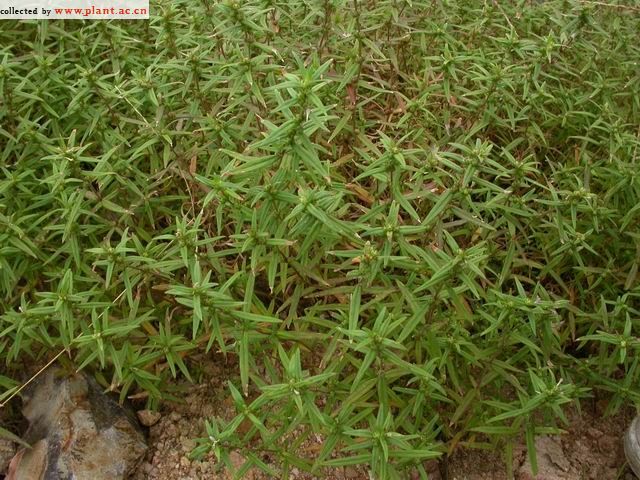山东丰花草Borreria shandongensis F. Z. Li et X. D. Chen
山东丰花草Borreria shandongensis F. Z. Li et X. D. Chen
3.山东丰花草(云南植物研究)
Borreria shandongensis F. Z. Li et X. D. Chen in Acta Bot. Yunnan. 7 (4): 419-420, 图1. 1985.
一年生草本,分枝多,直立或斜升,高10-30厘米;枝微呈四棱形,被短毛。叶纸质,无柄,线状披针形,长2-4厘米,宽3-5毫米,顶端渐尖,两面粗糙,干后边缘微背卷;侧脉不明显;托叶鞘顶端截平,具浅黄色长刺毛数条。花单生于叶腋,无梗;萼檐4裂,裂片卵状披针形,长约1毫米,被疏柔毛;花冠粉红色,近漏斗形,长约4毫米,顶部4裂,裂片长圆形;花丝贴生于花冠上,不伸出冠管外。蒴果倒卵形,长3-3.5毫米,被疏柔毛,成熟时2瓣裂,具种子2颗;种子长圆形,长约2.5毫米,干后黄褐色,有1条纵沟槽。花果期8-9月。
产山东青岛的崂山李村。
《Flora of China》 Vol. 19 (2011)
Diodia teres Walter Fl. Carol. 87. 1788.
山东丰花草 shan dong feng hua cao
Borreria shandongensis F. Z. Li & X. D. Chen; Diodella teres (Walter) Small; Spermacoce shandongensis (F. Z. Li & X. D. Chen) Govaerts.
Herbs, annual, erect, to 30[-50] cm tall; stems somewhat flattened to slightly [or sharply] 4-angled, pilosulous [and/or pilose to glabrescent]. Leaves sessile; blade drying papery, linear-lanceolate, [8-]20-40 × [1-]3-5[-7] mm, both surfaces hispidulous, base obtuse [to rounded or subcordate], margin weakly [to strongly] revolute, apex acute to acuminate; secondary veins indistinct; stipule sheaths truncate, 1-2.5 mm, pilosulous to glabrescent, with 5-9 setae 1-7 mm. Flowers 1[-3] per axil or 1[-6] per node; bracts reduced. Calyx pilosulous to glabrescent; ovary portion obovoid, 0.5-0.8 mm; limb deeply lobed; lobes lanceolate, ca. 1 mm, pilosulous to glabrescent. Corolla pink [to pale purple or blue], funnelform, hispidulous to glabrescent outside; tube [1.5-]4[-7] mm, glabrescent inside; lobes elliptic-oblong, 0.5-2 mm. Fruit obovoid, [1.5-]3-3.5 mm, papery to bony, hispid to hispidulous, separating into 2 mericarps each with a Y-shaped sulcus on adaxial surface; seeds ca. 2.5 mm, yellowish brown when dry, longitudinally 1-grooved. Fl. and fr. Aug-Sep.
Disturbed, often degraded open ground. S Fujian (Jinmen), Shandong (Qingdao) [native to Antilles and North and South America; adventive in N Africa, Japan, Korea, and Madagascar].
Diodia teres has not been widely reported previously from Asia, but it is known from Japan (Honshu, 18 Oct 1995, S. Tsuagaru & G. Murata 22898, MO!) at a similar latitude to its occurrence in China and probably should be expected elsewhere.Diodia teres has not been widely reported previously from Asia, but it is known from Japan (Honshu, 18 Oct 1995, S. Tsuagaru & G. Murata 22898, MO!) at a similar latitude to its occurrence in China and probably should be expected elsewhere.
科名:茜草科 Rubiaceae
属名:丰花草属 Borreria

3.山东丰花草(云南植物研究)
Borreria shandongensis F. Z. Li et X. D. Chen in Acta Bot. Yunnan. 7 (4): 419-420, 图1. 1985.
一年生草本,分枝多,直立或斜升,高10-30厘米;枝微呈四棱形,被短毛。叶纸质,无柄,线状披针形,长2-4厘米,宽3-5毫米,顶端渐尖,两面粗糙,干后边缘微背卷;侧脉不明显;托叶鞘顶端截平,具浅黄色长刺毛数条。花单生于叶腋,无梗;萼檐4裂,裂片卵状披针形,长约1毫米,被疏柔毛;花冠粉红色,近漏斗形,长约4毫米,顶部4裂,裂片长圆形;花丝贴生于花冠上,不伸出冠管外。蒴果倒卵形,长3-3.5毫米,被疏柔毛,成熟时2瓣裂,具种子2颗;种子长圆形,长约2.5毫米,干后黄褐色,有1条纵沟槽。花果期8-9月。
产山东青岛的崂山李村。
《Flora of China》 Vol. 19 (2011)
Diodia teres Walter Fl. Carol. 87. 1788.
山东丰花草 shan dong feng hua cao
Borreria shandongensis F. Z. Li & X. D. Chen; Diodella teres (Walter) Small; Spermacoce shandongensis (F. Z. Li & X. D. Chen) Govaerts.
Herbs, annual, erect, to 30[-50] cm tall; stems somewhat flattened to slightly [or sharply] 4-angled, pilosulous [and/or pilose to glabrescent]. Leaves sessile; blade drying papery, linear-lanceolate, [8-]20-40 × [1-]3-5[-7] mm, both surfaces hispidulous, base obtuse [to rounded or subcordate], margin weakly [to strongly] revolute, apex acute to acuminate; secondary veins indistinct; stipule sheaths truncate, 1-2.5 mm, pilosulous to glabrescent, with 5-9 setae 1-7 mm. Flowers 1[-3] per axil or 1[-6] per node; bracts reduced. Calyx pilosulous to glabrescent; ovary portion obovoid, 0.5-0.8 mm; limb deeply lobed; lobes lanceolate, ca. 1 mm, pilosulous to glabrescent. Corolla pink [to pale purple or blue], funnelform, hispidulous to glabrescent outside; tube [1.5-]4[-7] mm, glabrescent inside; lobes elliptic-oblong, 0.5-2 mm. Fruit obovoid, [1.5-]3-3.5 mm, papery to bony, hispid to hispidulous, separating into 2 mericarps each with a Y-shaped sulcus on adaxial surface; seeds ca. 2.5 mm, yellowish brown when dry, longitudinally 1-grooved. Fl. and fr. Aug-Sep.
Disturbed, often degraded open ground. S Fujian (Jinmen), Shandong (Qingdao) [native to Antilles and North and South America; adventive in N Africa, Japan, Korea, and Madagascar].
Diodia teres has not been widely reported previously from Asia, but it is known from Japan (Honshu, 18 Oct 1995, S. Tsuagaru & G. Murata 22898, MO!) at a similar latitude to its occurrence in China and probably should be expected elsewhere.Diodia teres has not been widely reported previously from Asia, but it is known from Japan (Honshu, 18 Oct 1995, S. Tsuagaru & G. Murata 22898, MO!) at a similar latitude to its occurrence in China and probably should be expected elsewhere.

